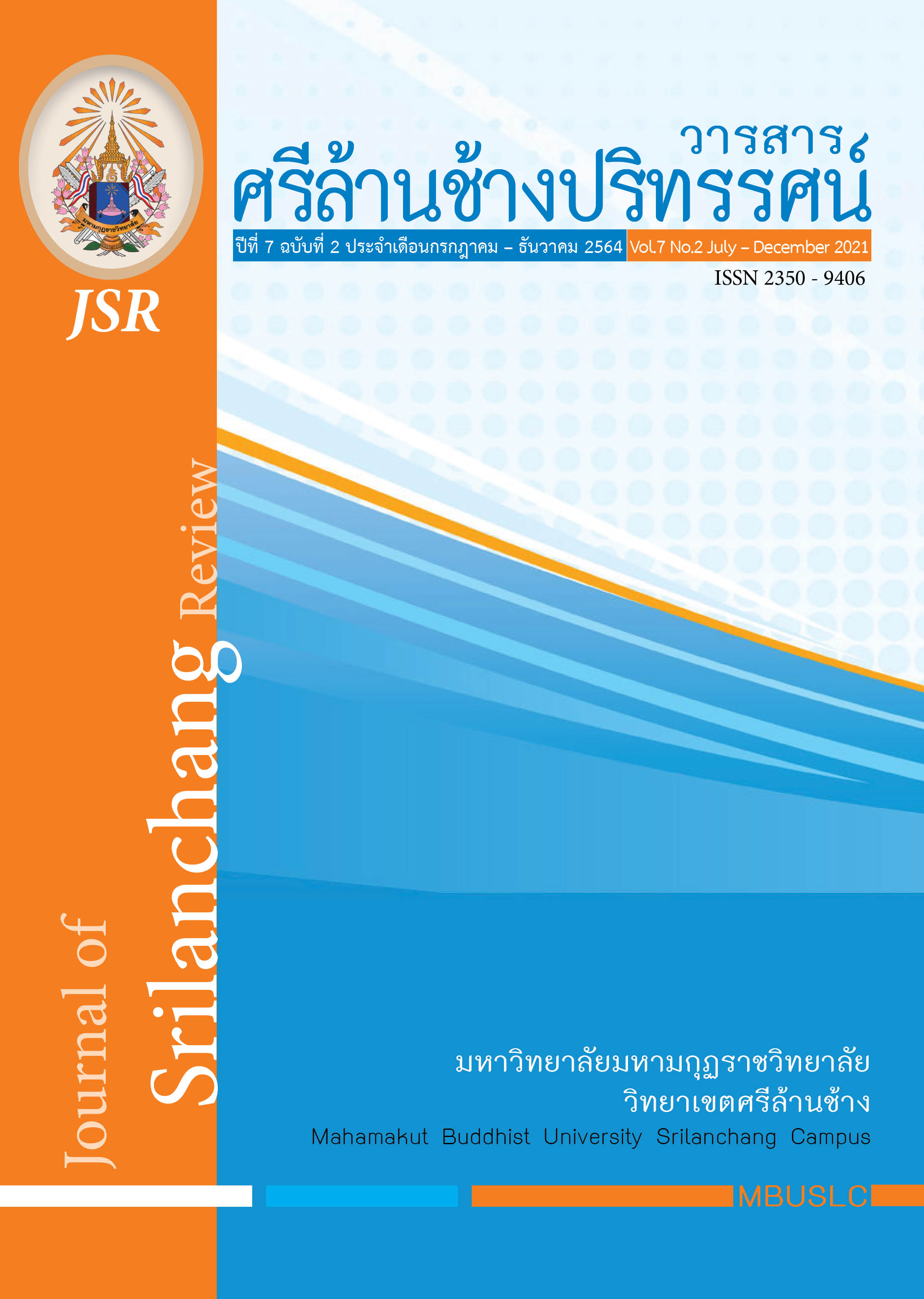LINGUISTIC STRATEGIES IN CONSTRUCTION OF SACRED SPACE IN MAGICAL REALISM “NANG PHYA ASORAPHIT”
Main Article Content
Abstract
The objective of the academic article was to study the linguistic strategies in the construction of the sacred space in Tri Aphirum’s magical realism novel Nang Phya Asoraphit (Queen Snake),” based upon the concepts of sacred space, magical realism, and meaning construction. Tri Aphirum was a pseudonym or a pen name of Thep Chumsai Na Ayutthaya, honoured and praised as one of Thailand’s national artists in the field of literary art. The sacred space was studied through six linguistic strategies, namely, 1) realistic narration, 2) surrealistic narration, 3) emotional narration, 4) narration on offense and violence, 5) narration on political thoughts, and 6) borrowings from Pali and Sanskrit. The study revealed that the sacred space in Tri Aphirum’s magical realistic novel Nang Phya Asoraphit was constructed through the following linguistic strategies: 1. The realism was periodically inserted and described through the historical narratives at that time. 2. The surrealism was proclaimed through people’s beliefs in enigmatic mysteries, including a soul, with some questions on death and supernatural things. 3. The emotional narration was aimed at encouraging the readers to go along with the fiction and believe in the law of action (Karma). The offense and violence were differently narrated by imitating the social events in reality and exactly expanding them through the writer’s imagination in human life. 5. The narration of political thoughts at that time was communicated in the formations of political philosophical discussion and political struggle. 6. Pali and Sanskrit words, regarded as the high-class alternatives, were borrowed to communicate Buddhist teachings.
Article Details

This work is licensed under a Creative Commons Attribution-NonCommercial-NoDerivatives 4.0 International License.
บทความที่ได้รับการพิจารณาจากคณะกรรมการผู้ทรงคุณวุฒิและเผยแผ่ในวารสารฉบับนี้ เป็นทัศนคติและข้อคิดเห็นส่วนบุคคลของผู้เขียนแต่ละท่าน ไม่ถือว่าเป็นทัศนะคติและความรับผิดชอบ
ของบรรณาธิการ
บทความ ข้อมูล เนื้อหา รูปภาพ ฯลฯ ที่ได้รับการตีพิมพ์ในวารสารศรีล้านช้างปริทรรศน์ ถือเป็นลิขสิทธิ์ของวารสารศรีล้านช้างปริทรรศน์ หากบุคคลหรือหน่วยงานใดต้องการนำทั้งหมดหรือส่วนหนึ่งส่วนใดไปเผยแพร่ต่อหรือเพื่อกระทำการใด ๆ จะต้องได้รับอนุญาตเป็นลายลักอักษรจากวารสารศรีล้านช้างปริทรรศน์ ก่อนเท่านั้น
References
กาญจนา แก้วเทพ. (2544). ศาสตร์แห่งสื่อและวัฒนธรรมศึกษา. กรุงเทพ: เอดิสันเพรสโปรดักส์.
กิตติยา คุณารักษ์. (2564). พื้นที่ศักดิ์สิทธิ์ในนวนิยายแนวสัจนิยมมหัศจรรย์ของตรี อภิรุม: ความหมายและการประกอบสร้าง. วิทยานิพนธ์ ศศ.ม. (ภาษาไทย). มหาสารคาม: บัณฑิตวิทยาลัย มหาวิทยาลัยมหาสารคาม.
ชูศักดิ์ ภัทรกุลวณิชย์. (2559). สัจนิยมมหัศจรรย์ ในงานของกาเบรียล การ์เซีย มาร์เกซ, โทนี มอร์ริสัน และวรรณกรรมไทย. กรุงเทพฯ: สำนักพิมพ์อ่าน.
ตรี อภิรุม. (2551). นางพญาอสรพิษ. พิมพ์ครั้งที่ 2. นนทบุรี: สำนักพิมพ์อุทยานความรู้.
ธีระพงษ์ มีไธสง. (2560). ผีกับพุทธการผสมผสานทางความเชื่อ. กรุงเทพฯ: สำนักพิมพ์อินทนิล.
ธัญญา สังขพันธานนท์. (2539). วรรณกรรมวิจารณ์. กรุงเทพฯ: สำนักพิมพ์นาคร.
นพวรรณ รองทอง. (2543). กำเนิดและพัฒนาการของนวนิยายสัจนิยมแนวมหัศจรรย์. กรุงเทพฯ: สำนักพิมพ์แห่งจุฬาลงกรณ์มหาวิทยาลัย.
บุญยงค์ เกศเทศ. (2557). ผีวิถีคน ความเชื่อและการพึ่งพาระหว่างคนกับผี. มหาสารคาม: สำนักพิมพ์กากะเยีย.
บุญเหลือ โจมโน. (2556). ภาษาบาลีสันสกฤตในภาษาไทย. กรุงเทพฯ: สำนักพิมพ์แดเน็กซ์ อินเตอร์.
ศรีศักร วัลลิโภดม. (2542). ภูเขาศักดิ์สิทธิ์กับความเป็นสากล. กรุงเทพฯ: สำนักพิมพ์เมืองโบราณ.
ศรีศักร วัลลิโภดม. (2562). พระพุทธศาสนาและความเชื่อของสังคมไทย. พิมพ์ครั้งที่ 3. กรุงเทพฯ: มูลนิธิเล็ก - ประไพ วิริยะพันธ์.
สุรเดช โชติอุดมพันธ์. (2554). สัจนิยมมหัศจรรย์ในวรรณกรรมของกาเบรียล การ์เซีย มาร์เกซ. กรุงเทพฯ: สำนักพิมพ์แห่งจุฬาลงกรณ์มหาวิทยาลัย.
ศรีศักร วัลลิโภดม. (2559). ทฤษฎีวรรณคดีวิจารณ์ตะวันตกในคริสต์ศตวรรษที่ 20. กรุงเทพฯ: สำนักพิมพ์แห่งจุฬาลงกรณ์มหาวิทยาลัย.
รื่นฤทัย สัจจพันธุ์. (2561). นัยในวรรณกรรม. กรุงเทพฯ: สำนักพิมพ์แสงดาว.


